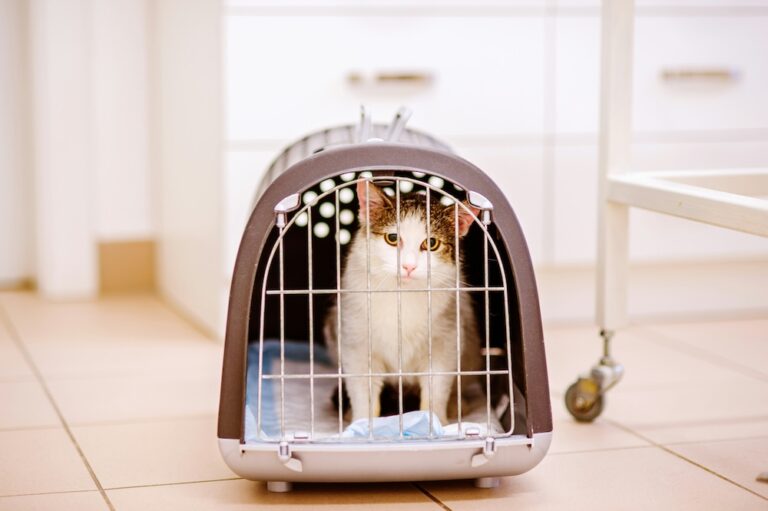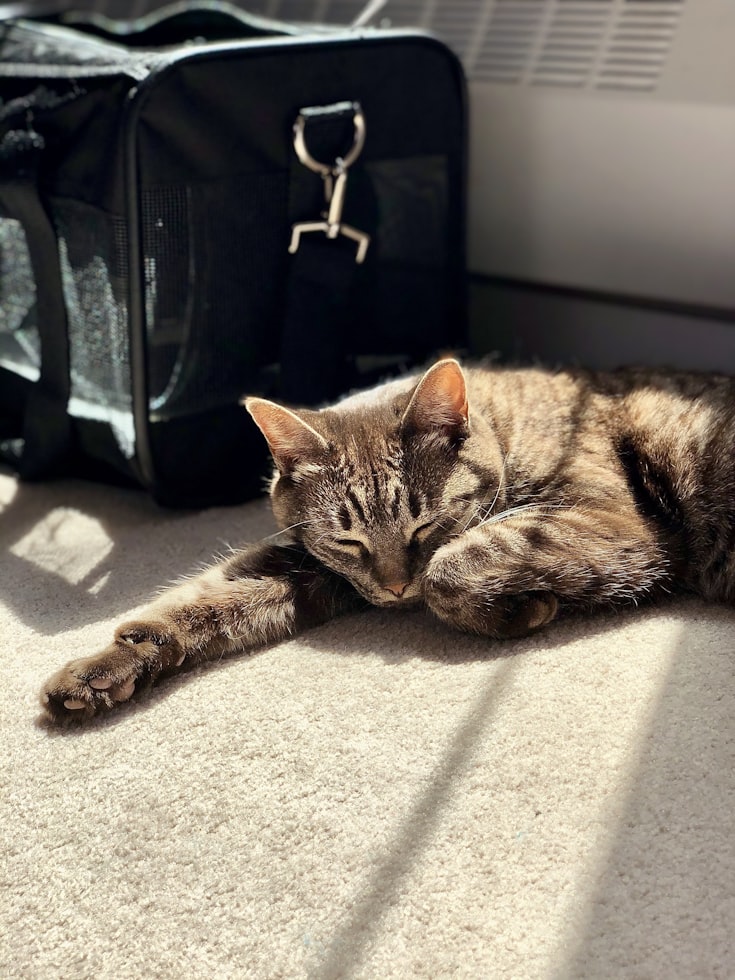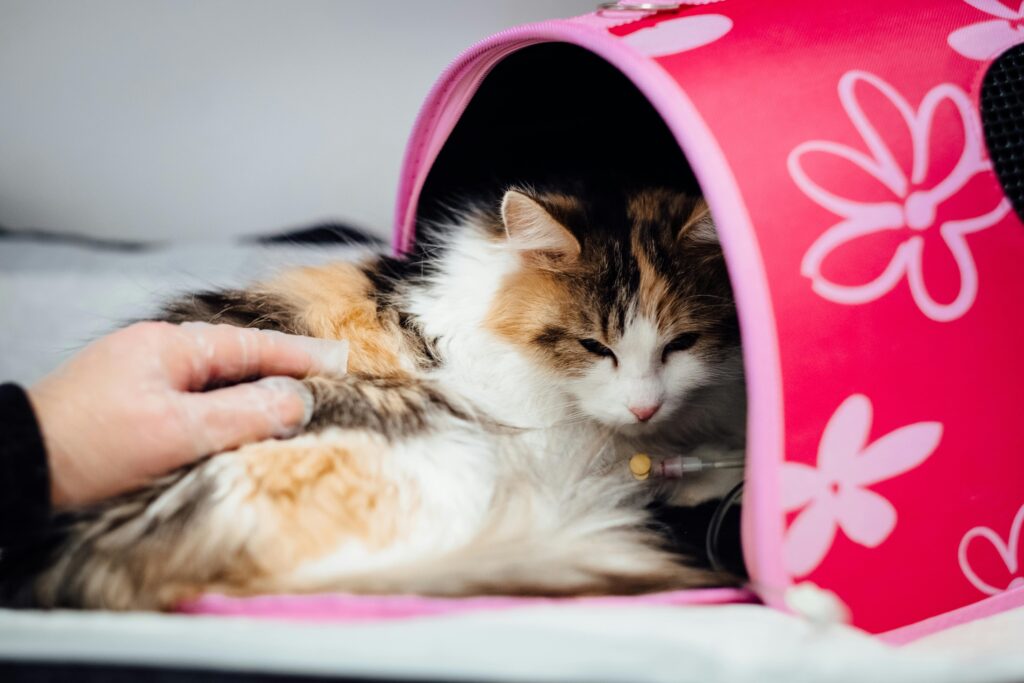You know how it goes. The vet appointment’s coming up, you pull the cat carrier out, and—poof—your cat disappears.
Suddenly, they’ve turned into a furry Houdini, hiding under the bed or wedged behind the closet.
Then comes the showdown: you versus a very determined cat. By the time you both make it to the vet, everyone’s stressed out and slightly resentful.
It’s a familiar story, but it doesn’t have to be this way.
The trick is figuring out what’s making your cat anxious and picking a carrier that actually feels safe to them.
That’s what we’ll talk about here: how to find the best cat carriers for nervous cats and how to use them so your next vet trip is a little less chaotic.
Contents
- 1 Why Do Cats Hate Their Carriers?
- 2 What Makes a Great Cat Carrier for an Anxious Cat?
- 3 The 7 Best Cat Carriers For Nervous Cats
- 3.1 1. Best for Vet Visits: Petmate Two-Door Top-Load Kennel
- 3.2 2. Best for Air Travel: Mr. Peanut’s Expandable Airline-Approved Carrier
- 3.3 3. Best for Safety (Crash-Tested): Sleepypod Air
- 3.4 4. Best for Large Cats: Petseek Extra Large Cat Carrier
- 3.5 5. Best for Long Waits: Siivton 4-Sides Expandable Carrier
- 3.6 6. Best Collapsible (Hard-Sided): SportPet Designs Foldable Carrier
- 3.7 7. Best for Walking: Halinfer Space Capsule Backpack
- 4 How to Train Your Cat to Love Their Carrier
- 5 A Final Thought
Why Do Cats Hate Their Carriers?

It’s easy to think your cat is just being dramatic. But really, it’s all instinct.
It Feels Like a Trap

Cats love cozy, dark spaces. Just look at how fast they dive into a cardboard box. To them, that’s a safe hideout. But a carrier? That’s different. Once they’re inside, the door shuts and they can’t leave. They lose all control, and that’s terrifying for an animal built to survive by staying alert and free.
Bad Memories Stick

Think about when you usually bring out the carrier. It’s almost always before a car ride, and that ride usually ends at the vet. Your cat notices patterns. They see the carrier and think, “Oh no, not again.” Before you’ve even picked it up, they’re already planning their escape.
They Pick Up on Your Energy

Cats are ridiculously good at reading us. If you start getting tense (because you know the battle is coming), they can tell. They can even smell changes in your body when you’re stressed.
So when you act nervous, your cat thinks, “Yep, something bad’s happening,” and their anxiety doubles.
It’s not that your cat hates you or even the carrier itself. They’re just reacting to what it represents, and to your own stress that confirms their fears.
What Makes a Great Cat Carrier for an Anxious Cat?

Picking the right carrier is half the battle. Forget the fancy extras or cute designs. What really matters are a few simple things that make your cat feel safe and you less stressed.
- A Removable Top
Vets love carriers that can be unclipped and opened from the top. That way, your cat can stay in the bottom half, their little “safe zone”, while the vet does most of the exam. No dragging, no wrestling, no panic. Just a calmer experience for everyone.
- Easy Top Access
If the top doesn’t come off, go for a carrier that opens from above. Cats hate being shoved headfirst into a dark box, as it feels like a trap. When you can lower them in gently, feet first, it feels less threatening and way more natural for them.
- Secure and Escape-Proof
An anxious cat will test every weak spot. So a sturdy, well-secured carrier is a must.
Hard-sided carriers are solid, easy to clean, and generally preferred by vets.
Soft-sided ones are lighter and handy for travel, but cheap zippers are a problem. Some cats can literally paw their way out.
If you’re going soft-sided, look for one with locking zippers. It’s a small feature that makes a big difference.
- Privacy and Stability
Cats don’t need panoramic views when they’re scared. In fact, too much visibility can make things worse. A good carrier gives them the option to hide, like one with a roll-down cover or darker sides. It turns the space into a little den where they can decompress.
And don’t forget the base. Make sure it’s firm, not saggy. A wobbly floor makes cats feel unstable and adds to their stress.
The 7 Best Cat Carriers For Nervous Cats
We went through some of the most popular options out there, focusing on what vets actually recommend, not just what looks nice online. Here’s the shortlist.
1. Best for Vet Visits: Petmate Two-Door Top-Load Kennel

The real win, though, is the two-door design. You get the usual front door and a top-loading one. That top door makes life so much easier when you’re dealing with a nervous cat. You can just lower them in calmly instead of forcing them through a small front gate.
It’s roomy enough for comfort, has great airflow, and doesn’t rattle or flex in the car. Basically, it’s all the good stuff without the gimmicks.
- Best Feature: Top-loading door for easy, low-stress loading
- Material: Hard plastic with steel doors
- Best For: Vet visits, short car rides, or cats that panic easily
2. Best for Air Travel: Mr. Peanut’s Expandable Airline-Approved Carrier

The first thing you’ll appreciate is the auto-locking zippers. They’re a small detail that makes a huge difference since your cat can’t push or paw them open mid-flight. Then there’s the roll-down privacy cover, which turns the carrier into a cozy, dark den when the airport chaos gets too much.
It’s also got a top-loading door for easy access, a sturdy base that doesn’t sag under your cat’s weight, and an internal leash tether for extra safety. One side even expands into a little “room” so your cat can stretch out during layovers.
It checks every box for comfort, safety, and sanity, both yours and your cat’s.
- Best Feature: Auto-locking zippers and roll-down privacy cover
- Material: Soft-sided nylon
- Best For: Air travel, road trips, or anyone who needs a secure, escape-proof carrier
3. Best for Safety (Crash-Tested): Sleepypod Air

Yes, it’s pricey. But it’s built like a small fortress wrapped in comfort. The cool part is that it doubles as a luxury bed at home. That means your cat can nap in it every day, so when it’s time to travel, it already feels familiar and safe. No more “I hate this thing” moments.
At the vet, the walls unzip from the base so your cat can stay in their bed during the exam. No pulling, no panic. For flights, it even compresses to fit under most airline seats while still giving your cat enough room to move around.
It’s the perfect mix of safety, comfort, and smart design.
- Best Feature: Crash-tested for car safety and converts into a bed
- Material: Soft-sided nylon
- Best For: Car travel, flights, and cat owners who want the safest setup possible
4. Best for Large Cats: Petseek Extra Large Cat Carrier

The Petseek Extra Large Carrier fixes that problem with a built-in steel frame. It gives you the strength of a hard-sided crate without the bulk. The frame keeps everything firm and upright, so your cat feels steady and supported the whole time.
It’s surprisingly lightweight and folds flat when you’re done, which is great for storage. Add in locking zippers and a seatbelt strap for car safety, and you’ve got a roomy, secure carrier that can handle even the biggest cuddle monster.
- Best Feature: Sturdy steel frame that keeps the carrier from sagging
- Material: Soft-sided fabric with internal steel frame
- Best For: Large cats or multi-cat households
5. Best for Long Waits: Siivton 4-Sides Expandable Carrier

At first glance, it looks like a normal soft carrier. But once you set it down, all four sides unzip and fold out, turning it into a roomy little playpen. Your cat suddenly has space to stand, stretch, and move around. That’s great during long waits!
It’s well-ventilated, with mesh panels on every side for airflow, and also includes a top-loading entry for easy access. The whole setup feels secure but comfortable, giving your cat a much-needed sense of freedom without losing safety.
- Best Feature: Four expandable sides that create a spacious, stress-free play area
- Material: Soft-sided fabric
- Best For: Air travel, long road trips, and airport layovers
6. Best Collapsible (Hard-Sided): SportPet Designs Foldable Carrier

The best part, though, is the extra-wide door. It swings open like a regular door instead of a small hatch, so your cat doesn’t feel trapped when going in or out. It’s a simple but smart design, especially for cats who hate the usual “push and shove” carrier routine.
The latch is sturdy and reliable, too, so you don’t have to worry about escapes mid-trip.
- Best Feature: The strength of a hard-shell carrier that folds flat for storage
- Material: Hard-sided plastic
- Best For: Car travel and small-space living
7. Best for Walking: Halinfer Space Capsule Backpack

The standout feature is its expandable back panel. When you stop walking, you can unzip it and it folds out like an accordion, creating a roomy, mesh-sided space where your cat can stretch out and relax. It turns a tight travel spot into a comfortable rest area in seconds.
One quick tip: skip the bubble window if your cat gets anxious. It looks cool, but that full 360-degree view can be too much stimulation for a nervous traveler. The mesh back is a calmer, cozier option that lets in air and light without overwhelming them.
- Best Feature: Expandable back that creates extra space when you stop
- Material: Mixed (backpack-style carrier)
- Best For: Walks, hikes, and public transit
How to Train Your Cat to Love Their Carrier

Getting a good carrier is only half the battle. The real trick is changing how your cat feels about it. With a little time and patience, you can turn that “scary trap” into a safe, familiar den your cat actually likes.
Here’s how.
Step 1: Make It Furniture
The biggest mistake people make is hiding the carrier until it’s time for the vet. To your cat, that’s like pulling out the monster once a year. Instead, leave it out all the time, like a piece of furniture.
If it’s a hard carrier, remove the top and the door so it’s just an open bed. Toss in a cozy blanket, your cat’s favorite bed, or even an old T-shirt that smells like you. Let your cat sniff it, nap in it, or ignore it, whatever they want. The key is to make it a normal, safe part of their world.
Step 2: Turn It Into a Restaurant
Now you want your cat to think of the carrier as a place where good things happen, like food. Start by putting treats or the food bowl near the carrier. Slowly move it closer every day until it’s right at the entrance, and then finally inside.
Feed them their regular meals there for a week or two. You can even throw in some “jackpot treats”, special stuff like tuna or chicken, that they only get in the carrier. Pretty soon, they’ll be walking in on their own.
Step 3: Use Calming Pheromones
A simple trick: spray the bedding with something like Feliway about 15 minutes before training or travel. It mimics the natural pheromones cats use to mark safe spaces. Studies show it helps reduce stress, meowing, and panting during travel.
Step 4: Practice Closing the Door
Once your cat’s happy eating inside, start gently closing the door for just a few seconds. Then open it, praise them, and give a treat. Do this in tiny steps, over several days, and slowly increase the time the door stays closed.
The goal isn’t to trap them. It’s to show them that the door closing doesn’t mean panic. It just means a few seconds of calm followed by a reward.
Step 5: Get Them Used to Being Lifted
When they’re relaxed inside with the door closed, it’s time to lift the carrier. Just hold it for five seconds, set it down, open it, and give a treat. Repeat this often.
Pro tip: always use both hands to lift. Support the bottom instead of using the handle. The swinging motion from the handle feels unstable and can scare them.
Step 6: Take Practice Rides
Now you’ll rewrite your cat’s mental script: “carrier = vet.”
Take your cat on short, harmless car trips. Just around the block and back home. Each time, reward them with their favorite treat when you return.
If you do this often enough, your cat learns that not every carrier trip ends with a thermometer or a needle. Nine times out of ten, it’ll end with a safe ride and a snack, and that’s the kind of math cats like.
A Final Thought

Even the best cat carrier in the world won’t magically fix everything on its own. The real secret is mixing the right carrier with the right approach.
A sturdy, secure carrier, especially one with a top-loading door, definitely makes things easier. But what really changes your cat’s behavior is the time and patience you put into training. That’s what turns the carrier from a scary box into a safe, familiar place.
You’ve got this. Your cat can learn to feel safe, and every vet trip from now on will get just a little bit easier!